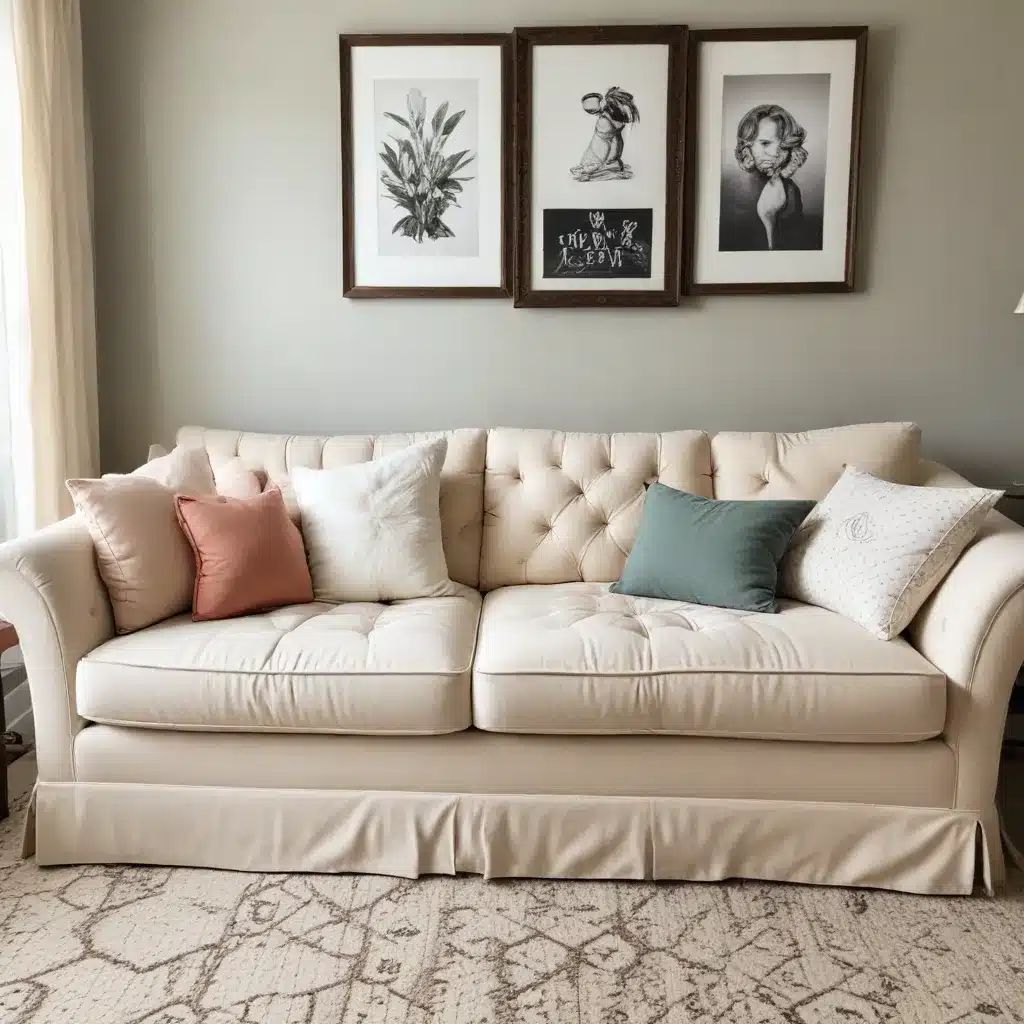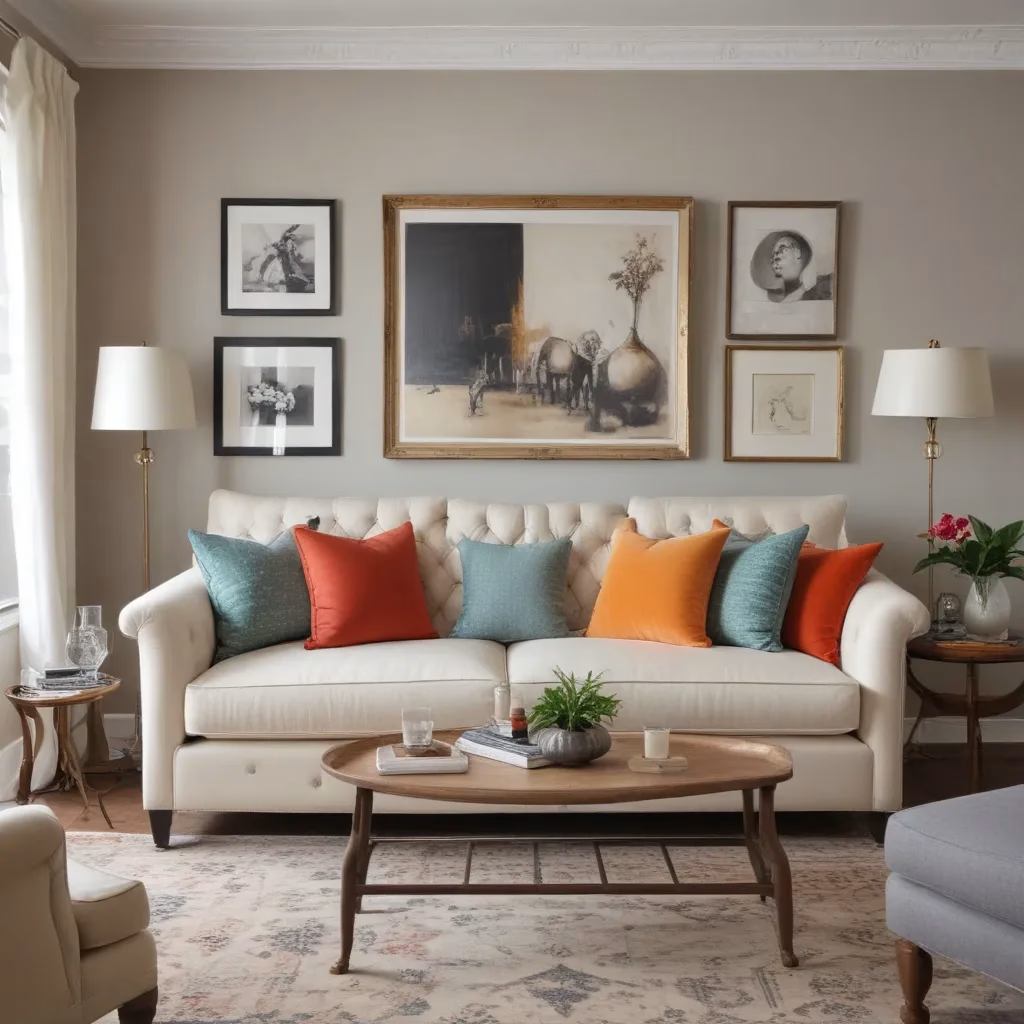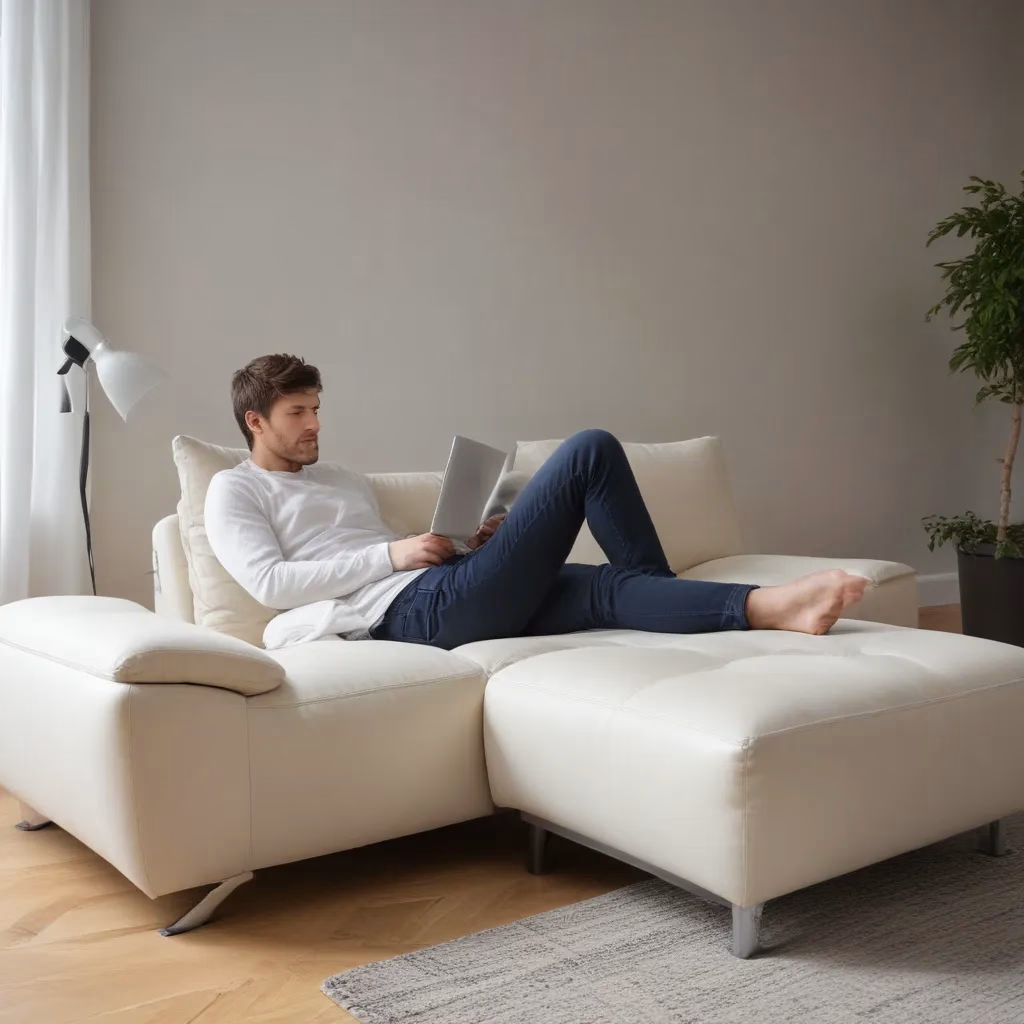
Finding the Perfect Thrifted Sofa
As someone who’s spent years in the furniture industry, I can tell you that finding a quality sofa at a thrift store is like striking gold. It’s an exhilarating treasure hunt that can yield amazing results if you know what to look for.
When I’m scouting thrift stores for sofas, I always start by examining the frame. A solid hardwood frame is the foundation of a durable sofa that can stand the test of time. I run my hands along the frame, feeling for any wobbliness or creaks that might indicate structural issues. If the frame feels rock-solid, that’s a great first sign.
Next, I take a close look at the cushions and upholstery. While worn fabric can easily be replaced, the underlying cushion quality is crucial. I give the cushions a good squeeze – they should be firm yet comfortable, without any lumps or sagging. Memory foam or high-density polyurethane foam tend to hold up best over time.
The style and silhouette of the sofa are also key considerations. I look for classic shapes that have stood the test of time – think clean lines, tufted backs, or graceful curves. These timeless designs are easy to update and integrate into various décor styles. I’ve found some incredible mid-century modern and vintage Chesterfield sofas this way that cleaned up beautifully.
Assessing the Sofa’s Potential
Once I’ve found a promising thrifted sofa, I take time to thoroughly evaluate its makeover potential. This involves looking beyond surface flaws to envision what the piece could become with some TLC.
I start by checking the sofa’s “bones” – the underlying structure and support system. I’ll flip the sofa over to examine the springs, webbing, and frame joints. Any broken springs or severely damaged frame pieces are red flags, as they can be challenging and costly to repair properly.
The cushion fill is another crucial element. While replacing the entire cushion is an option, it adds significant cost to the project. I give the cushions a thorough inspection, looking for any major lumps, tears, or odors that can’t be easily addressed. Minor flattening can often be remedied by adding extra batting or foam.
When it comes to upholstery, I assess both the current fabric condition and the ease of reupholstering. Sofas with simple, boxy shapes tend to be easier DIY projects. Those with complex curves or tufting may require professional help. I also check for any unique design elements like welting or button tufting that I’d want to recreate in the makeover.
Finally, I consider the sofa’s overall proportions and how they’ll fit in the intended space. A tape measure is your best friend here – I always come prepared to get exact dimensions. Even if the current fabric is dated, a well-proportioned sofa can become a true showpiece with the right makeover.
Planning Your Sofa Makeover
With your thrifted sofa selected, it’s time to plan out the transformation. This is where the real fun begins! I always start by creating a clear vision for the finished piece. Will it be a bold statement piece or blend seamlessly with existing decor? What’s the overall style you’re aiming for?
Choosing the right fabric is crucial to achieving your vision. I recommend ordering swatches of a few options to see how they look in your space. Consider factors like durability, ease of cleaning, and how the fabric will wear over time. For high-traffic areas or homes with pets and kids, performance fabrics can be a game-changer.
Color and pattern play a huge role in transforming your sofa. A neutral solid can create a timeless look, while a bold print can turn your sofa into a true focal point. Don’t be afraid to think outside the box – I once transformed a drab brown sofa into a stunning piece using a rich emerald velvet.
Beyond fabric, consider other elements you might want to change. New legs can completely alter the look of a sofa, taking it from traditional to mid-century modern with just a few screws. Swapping out cushion inserts can restore comfort and shape. You might even consider adding decorative nailhead trim or changing the cushion style for a more dramatic transformation.
Budget is an important consideration in your planning. While a thrifted sofa offers great savings, quality fabric and professional reupholstering can add up. I always recommend setting aside a budget for unexpected expenses – you never know what you might uncover once you start the makeover process.
Preparing Your Sofa for Transformation
Before diving into the makeover, proper preparation is key to achieving professional-looking results. I always start with a deep clean of the entire sofa. This helps remove any lingering odors and gives you a clean slate to work with.
For fabric sofas, I use a combination of vacuuming and spot-cleaning. A handheld steam cleaner can work wonders for lifting out old stains and refreshing the fabric. For leather sofas, a gentle leather cleaner helps remove dirt and condition the material.
Next, I address any structural issues. This might involve tightening loose joints, replacing worn webbing, or adding extra padding to flatten cushions. Taking the time to shore up the sofa’s structure now will ensure your makeover lasts for years to come.
If you’re planning to reupholster, this is the time to remove the old fabric. I always take plenty of photos and notes during this process to use as a reference when applying the new fabric. Pay attention to how the fabric is attached and any special details like welting or button tufting.
For DIY reupholstering, you’ll need to create a pattern using the old fabric as a guide. I like to use heavy kraft paper for this, carefully marking each piece and noting how they fit together. This step takes time but is crucial for achieving a polished final look.
Finally, make any necessary repairs to the wood frame. This might include filling small cracks, sanding rough spots, or touching up the finish on exposed wood elements. A little attention to these details can elevate your makeover from good to great.
Reupholstering Your Thrifted Sofa
Reupholstering is where your thrifted sofa truly begins its transformation into a showpiece. While it can be a challenging DIY project, the results are incredibly rewarding. I’ve tackled many reupholstery projects over the years, and I’m always amazed at the dramatic before-and-after.
Start by laying out your new fabric and cut pieces according to the pattern you created earlier. I always cut a little larger than needed to allow for adjustments. Remember to pay attention to pattern matching if you’re using a printed fabric – this can make or break the final look.
Attaching the new fabric is a step-by-step process that requires patience and attention to detail. I start with the inside back and work my way outwards, carefully stapling the fabric in place. It’s crucial to keep the fabric taut as you go to avoid wrinkles or bunching.
For cushions, I typically create new covers rather than trying to work with the old ones. This allows for a crisper, more professional finish. Zipper closures on cushion covers make them easy to remove for cleaning.
If your sofa has any special details like button tufting or decorative welting, now’s the time to recreate these. These touches can really elevate the final look of your piece. I’ve found that taking the time to perfect these details is what sets apart a professional-looking makeover from an obvious DIY job.
Remember, reupholstering is as much an art as it is a science. Don’t get discouraged if your first attempt isn’t perfect – it takes practice to achieve flawless results. The key is to take your time and don’t be afraid to redo sections if they’re not quite right.
Adding Finishing Touches
With the reupholstering complete, it’s time for those final touches that will truly make your thrifted sofa shine. This is where you can really let your creativity and personal style shine through.
New throw pillows are an easy way to add color, texture, and personality to your newly transformed sofa. I love mixing and matching different sizes, shapes, and fabrics to create a curated, designer look. Don’t be afraid to play with contrasts – a sleek, modern sofa can be softened with plush, textured pillows, while a traditional piece can be updated with geometric prints.
A cozy throw blanket draped over one arm or the back of the sofa adds both style and function. I often choose throws in complementary colors or textures to the upholstery fabric, creating a cohesive look.
Consider the sofa’s surroundings as well. A beautifully refinished side table or a statement lamp can complement your newly transformed sofa and pull the whole look together. I’ve found that pairing a bold, patterned sofa with simple, streamlined accent pieces creates a balanced and sophisticated look.
Lighting plays a crucial role in showcasing your revamped sofa. A well-placed floor lamp or table lamp can highlight the new fabric and create a warm, inviting atmosphere. I always recommend using warm-toned bulbs to enhance the coziness factor.
Finally, don’t forget about the floor space around your sofa. An area rug can define the seating area and add another layer of style and comfort. Choose a rug that complements your new sofa without overwhelming it – the goal is to create a harmonious overall look.
Maintaining Your Transformed Sofa
Now that you’ve put all this work into transforming your thrifted sofa, it’s important to keep it looking its best. Proper maintenance will ensure your sofa remains a showpiece for years to come.
Regular vacuuming is crucial for keeping your sofa looking fresh. I recommend using the upholstery attachment on your vacuum at least once a week to remove dust and debris. Pay special attention to crevices and seams where dirt can accumulate.
For fabric sofas, invest in a good fabric protector spray. This creates an invisible barrier that repels spills and stains, making cleanup much easier. I always test any new product on an inconspicuous area first to ensure it doesn’t affect the color or texture of the fabric.
Rotate cushions regularly to ensure even wear. This is especially important for sofas that get heavy use in one particular spot. I like to flip and rotate cushions every few weeks to maintain their shape and extend the life of the upholstery.
Address spills and stains immediately to prevent them from setting into the fabric. Keep a clean, white cloth handy for blotting spills – never rub, as this can push the stain deeper into the fibers. For tougher stains, consult a professional cleaner to avoid damaging your newly transformed sofa.
Protect your sofa from direct sunlight, which can fade and weaken fabric over time. If your sofa is near a window, consider using sheer curtains or UV-blocking window film to minimize sun damage.
Lastly, give your sofa some occasional TLC with a good deep clean. For fabric sofas, this might mean renting a steam cleaner or hiring a professional upholstery cleaning service. Leather sofas benefit from regular conditioning to keep the material supple and prevent cracking.
By following these maintenance tips, your transformed thrifted sofa will continue to be the star of your living space for years to come. Remember, a little regular care goes a long way in preserving the beauty of your furniture investment.
For more expert advice on sofa care and maintenance, be sure to check out our comprehensive guides at Sofa Spectacular. We’re here to help you keep your furniture looking spectacular!



